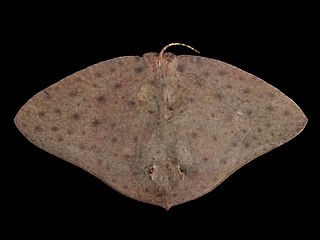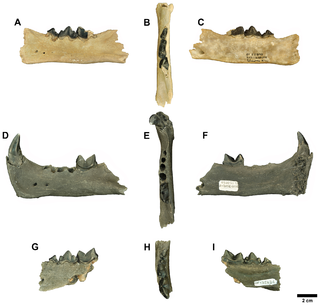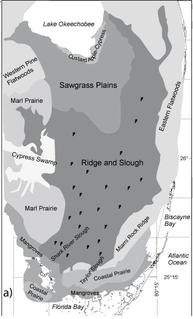
The University of Florida is a public land-grant research university in Gainesville, Florida. It is a senior member of the State University System of Florida and traces its origins to 1853 and has operated continuously on its Gainesville campus since September 1906.

Pineland is an unincorporated community and census-designated place (CDP) on Pine Island in Lee County, Florida, United States. The population was 407 at the 2010 census. It is part of the Cape Coral-Fort Myers, Florida Metropolitan Statistical Area.

The Atlantic goliath grouper or itajara, also known as the jewfish, is a large saltwater fish of the grouper family found primarily in shallow tropical waters among coral and artificial reefs at depths from 5 to 50 m. On the Western side, its range includes the Florida Keys in the US, the Bahamas, most of the Caribbean and most of the Brazilian coast. On some occasions, it is caught off the coasts of the US states of Maine and Massachusetts. In the eastern Atlantic Ocean, it occurs from the Congo to Senegal.

The broad-snouted caiman is a crocodilian reptile found in eastern and central South America, including southeastern Brazil, northern Argentina, Uruguay, Paraguay, and Bolivia. It is found mostly in freshwater marshes, swamps, and mangroves, usually in still or very slow-moving waters. It will often use man-made cow ponds.

The Caribbean sharpnose shark is a requiem shark, and part of the family Carcharhinidae.

The Red Triangle is the colloquial name of a roughly triangle-shaped region off the coast of northern California, extending from Bodega Bay, north of San Francisco, out slightly beyond the Farallon Islands, and down to the Big Sur region, south of Monterey. The area has a very large population of marine mammals, such as elephant seals, harbor seals, sea otters and sea lions, which are favored prey of great white sharks. Around thirty-eight percent of recorded great white shark attacks on humans in the United States have occurred within the Red Triangle—eleven percent of the worldwide total. The area encompasses the beaches of the heavily populated San Francisco Bay Area, and many people enjoy surfing, windsurfing, swimming and diving in these waters.

The scrawled cowfish is a species of boxfish native to the eastern Atlantic. They range in size from 8–15 inches (20–38 cm), with a maximum length of 18 inches (46 cm), and can be found at depths between 6 and 80 feet. It is common to occasional in Florida and Bahamas; occasional to uncommon in the Caribbean. It also occurs in the Gulf of Mexico, north to Massachusetts, Bermuda and south to Brazil in tropical and warm temperate waters.

The smooth butterfly ray is a species of cartilaginous fish in the family Gymnuridae. It is a member of the order Myliobatiformes, which contains 10 total families. Its natural habitats are shallow seas, subtidal aquatic beds, estuarine waters, and coastal saline lagoons. Its common name is derived from its compressed body, pectoral fins that are wider than their length, and overall diamond shape.
The glossy crayfish snake is a subspecies of nonvenomous snake endemic to the southeastern United States. Its scientific name, rigida, derives from the fact that it is comparatively stiff.

The Gulf crayfish snake is a subspecies of nonvenomous snake endemic to the southeastern United States.
David William Steadman is a paleontologist and ornithologist, and serves as the curator of ornithology at the Florida Museum of Natural History at the University of Florida.
Metatomarctus is an extinct genus of the Borophaginae subfamily of canids native to North America. It lived during the Early to Middle Miocene, 23—16 Mya, existing for approximately 7 million years It was an intermediate-size canid, and more predaceous than earlier borophagines.

The thorny skate is a species of fish in the family Rajidae. This bottom-living skate lives in the North and south-eastern Atlantic Ocean in depths ranging from 20 to 1,000 m (66–3,281 ft) and water temperatures from −1 to 14 °C (30–57 °F).

The live sharksucker or slender sharksucker is a species of marine fish in the family Echeneidae, the remoras.
Diaethria ceryx, the Ceryx eighty-eight, is a species of butterfly of the genus Diaethria. Diaethria ceryx was recorded for the first time in the coastal mountains in Manabí, Ecuador.

Lampropeltis getula floridana or the Florida kingsnake is a snake species native to southern Florida. On average, they grow between 3.5–5 ft but 6 ft individuals have been recorded.
Allen Hiram Curtiss (1845–1907) was a noted botanist in the United States. He may have been the first professional botanist to reside in Florida. His work included the discovery of fern species at the Pineola Grotto. He collected many specimens and was an author of botanical books. The Florida Agricultural Experiment Station, employed Curtiss for a brief tenure and several collections at the University of Florida Herbarium are named for him. Several species are named for him including Calamagrostis curtissii and Polygala curtissii

Rhizosmilodon is an extinct genus of saber-tooth cat of the subfamily Machairodontinae that lived during the Early Pliocene and was discovered in the U.S. state of Florida. Comparable in size to a medium-sized modern jaguar at about 165 lb. in weight, fossils of Rhizosmilodon are known only from Florida. The best specimens for this species are its lower jaw and teeth, which carry intermediate characteristics between advanced forms such as Smilodon and primitive forms such as Paramachairodus. It was likely an ambush predator, preying on animals such as deer, tapirs and horses.

Heliconius demeter, the Demeter longwing, is a butterfly of the family Nymphalidae. It was described by Otto Staudinger in 1897. It is found in the Northern and Eastern part of the Amazon basin, from Guyana to Northern Brazil and Peru. The habitat consists of sandy rainforests.

Marl prairies are wet prairies that allow for a slow seepage of overland water and exist in the Everglades, usually bordering deeper sloughs, and contain low-growth vegetation.














